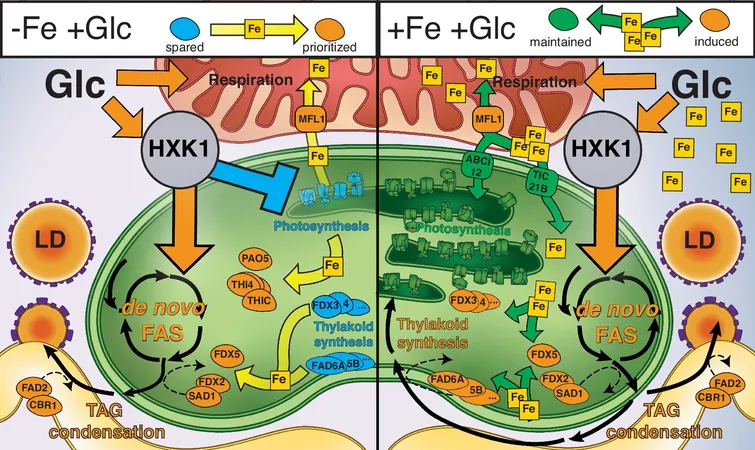
Unlocking the Secrets of Photosynthesis: How Iron and Metabolism May Revolutionize Biofuel Production!
2024-09-27
Introduction
The single-celled green alga, Chromochloris zofingiensis, is stepping into the spotlight as an innovative model organism for research in photosynthesis and metabolic processes. Recent studies indicate that this remarkable alga exhibits a fascinating metabolic flexibility: when supplied with glucose, it halts photosynthesis and instead focuses on accumulating substantial amounts of lipids, which are essential precursors for biofuels, as well as astaxanthin, a lucrative antioxidant.
Recent Discoveries
A groundbreaking study conducted by scientists from the University of California, Berkeley, in collaboration with the Environmental Molecular Sciences Laboratory (EMSL), has uncovered that the presence of iron—when combined with glucose—enables Chromochloris zofingiensis to sustain its photosynthetic activity and maintain its thylakoids, the critical membranes integral to photosynthetic energy transfer. Astonishingly, the cells still manage to accumulate lipids even while photosynthesis is ongoing.
Methodology
The researchers employed proteomic analysis through EMSL, revealing an intricate metabolic wiring linked to the cessation of photosynthesis and concurrent lipid accumulation. Utilizing advanced transmission electron microscopy techniques, they were able to visualize vital cellular structures, including thylakoids, starch reserves, and the actual lipid loads being stored.
Results and Findings
Combining their physiological analyses, the researchers concluded that the repression of photosynthesis triggered by glucose is closely tied to a strategic reallocation of iron resources. Instead of supporting photosynthetic machinery, these resources were redirected towards respiratory processes. Moreover, they identified a ferredoxin-dependent desaturase pathway that favored the storage of lipids, rather than the synthesis of thylakoid lipids.
Comparative Genomics
In a further leap of innovation, the research team performed comparative evolutionary genomics analyses on both green algae and vascular plants. This comparison revealed how metabolic and trophic constraints involving iron can significantly accelerate gene discovery processes, potentially unlocking new avenues for enhancing photosynthesis and biofuel production.
Conclusion
This comprehensive study not only positions Chromochloris zofingiensis at the foundation of the photosynthetic evolutionary tree but also highlights its impact on energy utilization and nutrient recycling. The implications of this research extend far beyond the lab; they provide a valuable framework for improving bioenergy crop yields and developing new bioproducts. As the world increasingly turns to sustainable energy sources, the lessons learned from this humble alga could be key to transforming the biofuel industry!
Call to Action
Stay tuned as we continue to uncover the hidden potentials of nature in our quest for sustainable energy solutions!



 Brasil (PT)
Brasil (PT)
 Canada (EN)
Canada (EN)
 Chile (ES)
Chile (ES)
 España (ES)
España (ES)
 France (FR)
France (FR)
 Hong Kong (EN)
Hong Kong (EN)
 Italia (IT)
Italia (IT)
 日本 (JA)
日本 (JA)
 Magyarország (HU)
Magyarország (HU)
 Norge (NO)
Norge (NO)
 Polska (PL)
Polska (PL)
 Schweiz (DE)
Schweiz (DE)
 Singapore (EN)
Singapore (EN)
 Sverige (SV)
Sverige (SV)
 Suomi (FI)
Suomi (FI)
 Türkiye (TR)
Türkiye (TR)